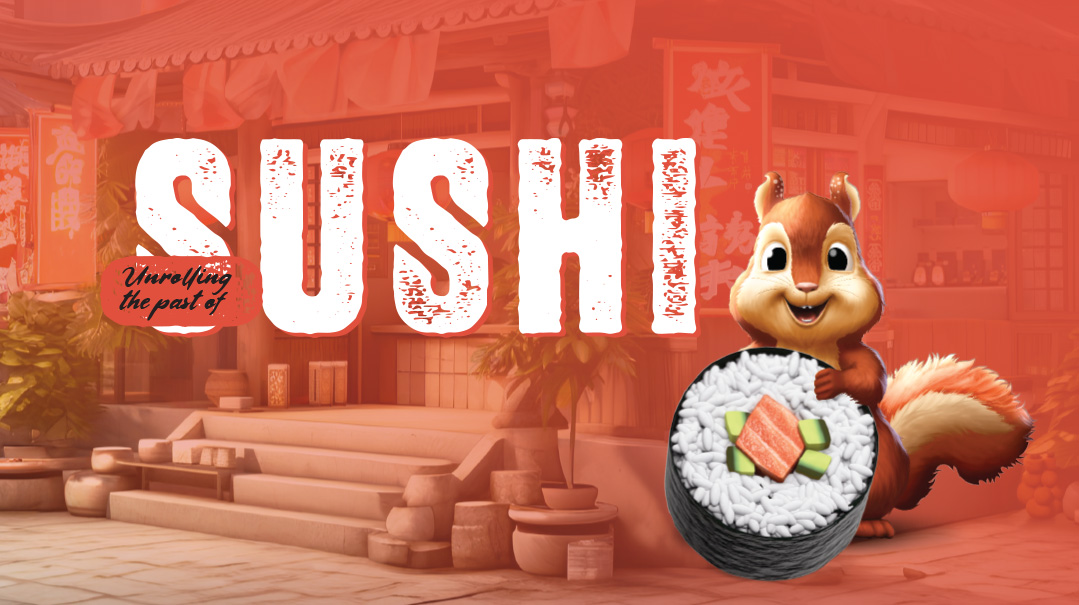Unrolling the Past of Sushi

Sushi is the quintessential Japanese food. Right? Nowadays, yes. But not always….

Fish plus rice plus seaweed equals sushi. Right? Nowadays, it does. But not always… And sushi is the quintessential Japanese food. Right? Nowadays, yes. But not always… What am I talking about? Well, sushi certainly didn’t start off looking (or smelling or tasting!) the way it does now. And it wasn’t even “invented” in Japan. (Can you keep a secret? Ramen, for which Japan is also famous, didn’t originate in Japan either. Neither did tempura, another “Japanese” food.) Want to learn more of sushi’s secrets? Read on.
2nd Century BCE−4th Century CE: Konnichiwa: Nare-Sushi
Let’s travel back a long time. It’s hard to know exactly what people were doing with their fish and when they were doing it. But sometime in these centuries, the Chinese, and possibly Koreans and other Southeast Asians (not the Japanese!), were fermenting fish using salt and rice. Fermenting is a way of preserving food so it doesn’t spoil. How do we know they were doing this? An ancient Chinese dictionary from the 4th century mentions it!
This fermented fish was sushi in its earliest form (even though no one knew what it would ultimately become!). Called nare-sushi, the fish fermenting process could take up to a year. When people ate the fish, they threw away the rice, using only the preserved fish. And that fish was probably quite pungent (that is, smelly). Pretty different from the sushi we know today!
8th or 9th Century CE: Sushi Travels to Japan
Fast forward hundreds of years to the 8th or 9th century… Again, we can’t know precisely when it happened, because ship inventory lists haven’t survived, but around this time, sushi was brought to Japan, probably by immigrants or travelers. Nothing really exciting happened, though, as the Japanese continued using the rice to preserve and enhance the flavor of the fish. They would then throw out the rice before eating the fish.
Around the 15th Century: Velcome Vinegar
Sushi undergoes a transformation finally! During Japan’s Muromachi period (1336−1573), vinegar became very popular in the country (though it had been there for probably close to a thousand years or more). During this time, people started mixing vinegar with the rice they were using to preserve their fish, which shortened the fermentation time. They also stopped tossing out their fish-preserving rice and ate it with their fish. The Japanese give this dish a new name: haya-zushi.
18th−19th Century: Sushi Grows Up
The Japanese city of Edo (now Tokyo) was one of the world’s largest cities (newsflash: it still is!). In Edo, something exciting was happening to sushi: Edo’s fishmongers were speeding up the fermentation process used for fish, as well as boiling it. Now the fish could be consumed a lot faster.
They made a pressed fish-rice combo, which was served in bite-sized pieces, so it looked a lot more like the sushi we know today. It was often topped with seafood and vegetables and was called nigiri-zushi (which means “hand-pressed”). Originally sold from street carts, sushi became increasingly popular across Edo. By the mid-19th century, there were numerous sushi restaurants in the city.
20th Century: Sushi Goes Global
In 1923, a terrible earthquake and ensuing fire almost destroyed Tokyo. The reconstruction work that followed brought workers from all over Japan. They loved the capital’s special dish, and they spread nigiri-zushi around the nation. The 20th century also marked sushi’s journey beyond Japan’s borders. Though sushi had been introduced to other cultures beforehand, it was only after World War II, when Japan’s economy and culture began to expand, that sushi really took off. Japanese immigrants and chefs brought sushi traditions with them all over the world, and sushi bars began to appear in global cities. People from different cultures enjoyed sushi for its unique flavor, appearance, and healthiness. Sushi chefs became artists, creating intricate sushi rolls that were beautiful and tasty.
Today: Sushi Sushi Everywhere
Today, sushi is everywhere, from fancy restaurants to your local grocer. You can still get it in its traditional forms, but there are also many modern varieties (like vegetarian sushi and California rolls) to appeal to all tastes.
The next time you eat sushi (or make it!), you can think about the long way it has come through history…and how much it has changed — from something we would consider to be pretty disgusting to something considered a special delicacy. That’s something to chew on!
Sushi Glossary
Maki: Sushi rolled in seaweed with rice, veggies, and sometimes fish inside, sliced into bite-sized pieces
Uramaki: Sushi rolls with rice on the outside, often garnished with sesame seeds or fish roe
Nigiri: Hand-pressed sushi consisting of a mound of rice with a slice of fish on top
Nori: Thin sheets of dried seaweed used to wrap sushi rolls
Futomaki: Thick sushi rolls with multiple ingredients
Sashimi: Thin slices of fresh (i.e., raw) fish usually served without any rice or veggies
Wasabi: A spicy condiment commonly served with sushi. Traditional wasabi is made from the root of the Wasabia japonica plant
Hosomaki: Thin sushi rolls with just one ingredient
(Originally featured in Treeo, Issue 985)
Oops! We could not locate your form.







